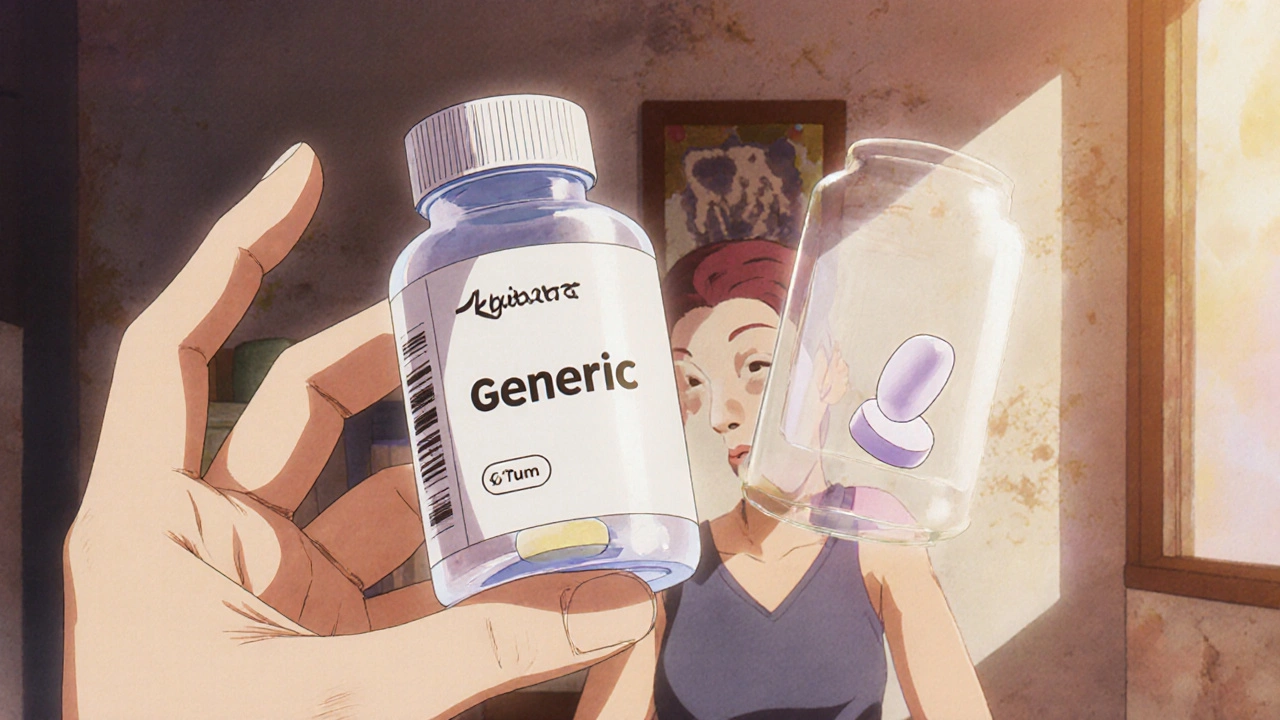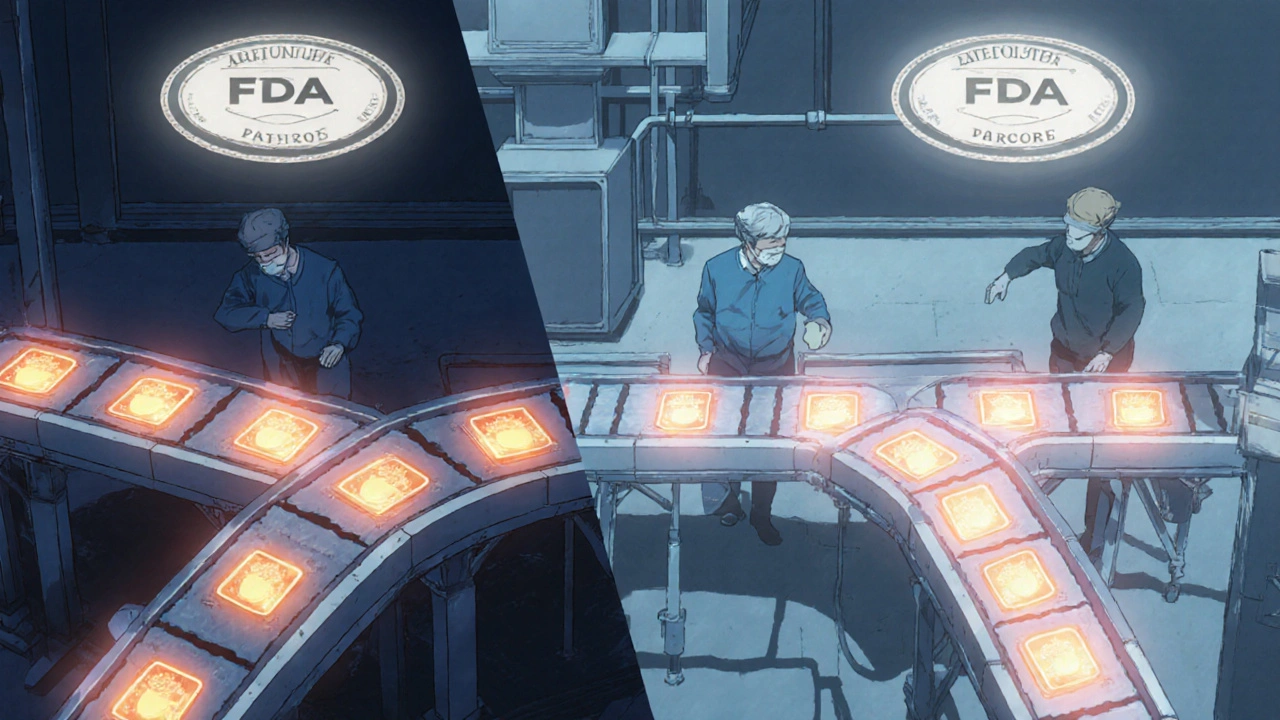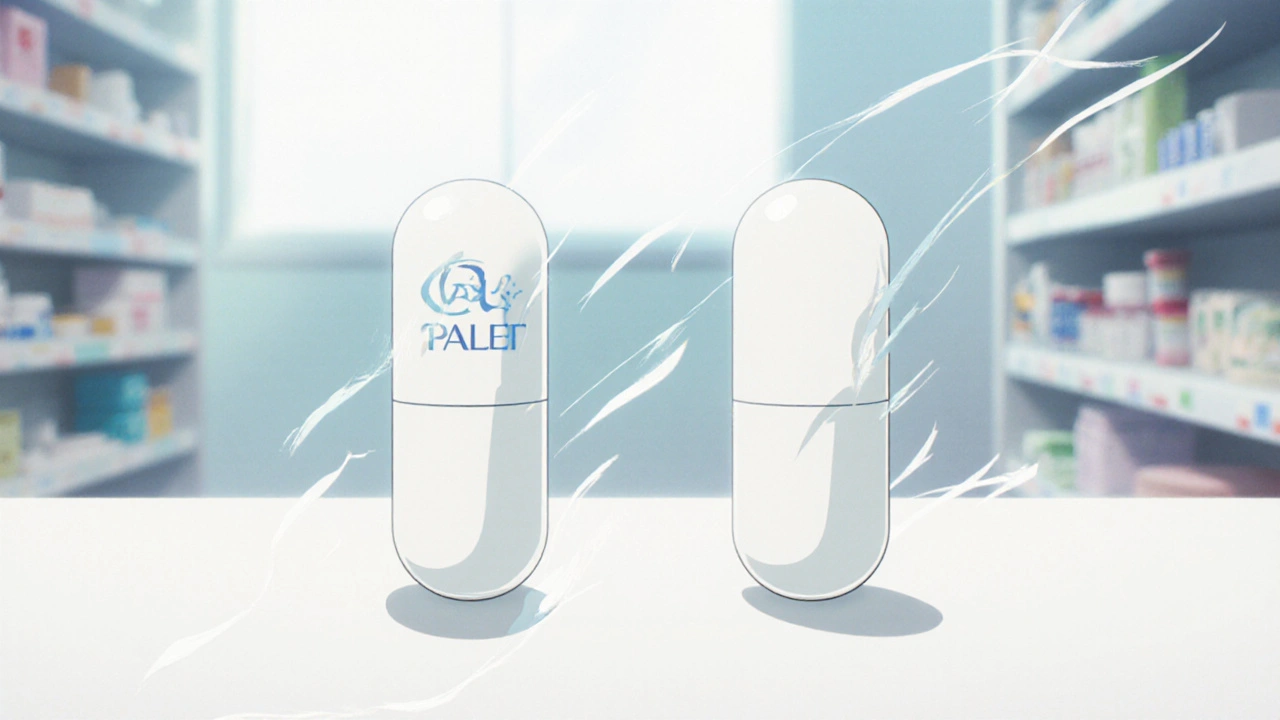When you pick up a prescription, you might see two pills that look almost identical-same size, same color, same strength-but one says brand name and the other says nothing at all. That’s an authorized generic. And if you’ve ever wondered whether it’s truly the same as the brand, the answer is simpler than you think: yes. They are the exact same drug, made in the same factory, with the same ingredients, under the same quality controls.
What Exactly Is an Authorized Generic?
An authorized generic isn’t a copy. It’s not a lookalike. It’s the original brand drug, stripped of its brand name and packaging. The same company that makes the brand-name version also makes the authorized generic. It’s the same pills, same capsules, same tablets-just sold under a different label. The U.S. Food and Drug Administration (FDA) defines them clearly: "Other than the fact that it does not have the brand name on its label, it is the exact same drug product as the branded product." This isn’t a loophole. It’s a legal pathway created by the Hatch-Waxman Act of 1984. That law let generic drugmakers enter the market, but it also let brand companies protect their profits by launching their own generics. When a patent expires, the brand company can start selling the exact same drug under a generic label-often at a lower price. This isn’t a trick. It’s transparency. You’re getting the same product, just without the marketing cost.How Authorized Generics Differ From Regular Generics
Regular generics are different. They’re made by other companies. They must prove they work the same way as the brand through bioequivalence studies. That means they have to deliver the same amount of active ingredient into your bloodstream within a certain range. But here’s the catch: they can have different fillers, dyes, and coatings. That’s allowed. And for most people, it doesn’t matter. But for some, it does.Authorized generics don’t have that problem. They use the same inactive ingredients as the brand. No substitutions. No changes. If your brand pill has a specific dye that helps you recognize it, the authorized generic has the same dye. If the brand uses a special coating to control how fast the drug releases, the authorized generic uses the exact same coating. That’s why patients who’ve had bad reactions to different fillers in regular generics often switch to authorized generics without issue.
There’s another technical difference: regulation. Regular generics go through the Abbreviated New Drug Application (ANDA) process. Authorized generics don’t. They’re approved under the original brand’s New Drug Application (NDA). That’s why you won’t find them listed in the FDA’s Orange Book-the official list of approved generics. They’re not technically generics in the regulatory sense. They’re the brand drug, repackaged.
Are They Really Therapeutically Equivalent?
Yes. And the evidence backs it up.A 2018 study tracked over 5,000 patients who switched from brand-name drugs to generics. About half switched to authorized generics. The researchers looked at hospital visits, emergency room trips, and whether people stopped taking their meds. The results? No meaningful difference. Patients on authorized generics had the same outcomes as those on the brand. Even the slightly higher emergency room visit rate for authorized generics-0.25 per patient-year versus 0.22 for regular generics-wasn’t clinically significant. It could have been random variation.
Dr. Janet Woodcock, former head of the FDA’s drug evaluation center, put it plainly: "Authorized generics provide the same therapeutic effect as the brand-name product." The American Managed Care Pharmacy Association agrees: "Patients and health care professionals can expect to see a clinical result and safety profile equal to that of the brand-name drug." Even experts who worry about narrow therapeutic index drugs-like warfarin or levothyroxine-admit the FDA’s quality controls are strict enough that batch-to-batch differences in authorized generics are negligible. The FDA tests every batch. If it doesn’t meet the standard, it’s destroyed. That applies to brand, authorized generic, and regular generic alike.

Why Do Some People Still Doubt Them?
Because of appearances.When you’ve been taking a blue pill with "Lipitor" printed on it for years, switching to a white pill with no name can feel like you’re getting something less. It’s psychology. It’s fear of the unknown. Some patients report feeling worse after switching-even though their blood tests show no change in drug levels. That’s not the drug’s fault. It’s the mind’s reaction to a change in appearance.
That’s why authorized generics exist. They’re the bridge. They let patients switch from a brand to a cheaper option without the visual shock. For birth control pills, epilepsy meds, or thyroid drugs-where consistency matters-authorized generics are often the preferred choice. Pharmacists see it all the time: patients who refused regular generics will take authorized generics without hesitation.
Cost and Availability
Authorized generics cost less than the brand-sometimes 30% to 50% less. But they’re usually more expensive than regular generics. Why? Because the brand company still controls production. They don’t have the same cost-cutting pressure as third-party generic makers. Still, they’re often cheaper than the brand, and they eliminate the risk of formulation changes.Not every drug has an authorized generic. They’re most common for high-demand, chronic-use medications: statins, blood pressure pills, antidepressants, and oral contraceptives. As of 2023, authorized generics make up about 5% to 7% of the generic drug market in the U.S. That’s small compared to the 90% of prescriptions filled with generics overall-but it’s growing. More insurers are adding them to preferred lists. More pharmacies are stocking them.

What You Should Do as a Patient
If you’re on a brand-name drug and cost is an issue, ask your pharmacist: "Is there an authorized generic for this?" Don’t assume your regular generic is the only option. Authorized generics are often hidden in pharmacy systems under different National Drug Codes (NDCs). They might show up as "generic" on your receipt, but the label will say nothing. If you’re unsure, ask to see the pill. Compare it to your old brand. If it looks identical, you’ve got an authorized generic.Don’t be afraid to ask for it. If your insurance covers it, they’ll likely charge you the generic copay. If they don’t, ask your doctor to write "dispense as written" on the prescription. That prevents automatic substitution to a regular generic that might have different fillers.
And if you’ve had issues with regular generics before-stomach upset, dizziness, or just a feeling that "it’s not working the same way"-try an authorized generic. You might find your symptoms disappear. Not because the drug changed. But because the pill you’re holding is the exact same one you were taking before.
Final Takeaway
Authorized generics aren’t a compromise. They’re the real thing. No shortcuts. No substitutions. Just the same drug, sold without the brand name. The FDA, doctors, researchers, and patients who’ve switched all agree: they work the same. They’re safe. They’re effective. And for many, they’re the best way to save money without sacrificing confidence in your medication.Are authorized generics FDA-approved?
Yes. Authorized generics are approved under the same New Drug Application (NDA) as the brand-name drug. They’re subject to the same manufacturing standards, quality controls, and inspections by the FDA. They’re not "unapproved" or "off-label." They’re legally marketed versions of the original drug, just without the brand name on the label.
Can I trust an authorized generic as much as the brand?
Absolutely. Authorized generics are made in the same facility, with the same equipment, by the same team, using the same raw materials as the brand-name version. The only difference is the label. If your brand drug is safe and effective, so is its authorized generic. The FDA treats them identically in terms of quality and safety monitoring.
Why aren’t authorized generics listed in the FDA’s Orange Book?
The Orange Book only lists drugs approved through the Abbreviated New Drug Application (ANDA) process. Authorized generics are approved under the original brand’s New Drug Application (NDA), so they don’t appear there. That doesn’t mean they’re not approved-it just means they’re categorized differently. If you need to verify an authorized generic, ask your pharmacist for the NDC or check the manufacturer’s website.
Do authorized generics cost more than regular generics?
Sometimes. Authorized generics usually cost less than the brand but more than regular generics because they’re produced by the original manufacturer without the economies of scale that third-party generic companies achieve. Still, they often cost 30% to 50% less than the brand-name version and are a good middle ground if you want identical formulation without paying brand prices.
How do I know if I’m getting an authorized generic?
Check the pill itself. If it looks exactly like your brand pill but has no brand name printed on it, it’s likely an authorized generic. Ask your pharmacist: "Is this an authorized generic?" They can check the NDC code and manufacturer. Some pharmacies label them as "authorized generic" on the receipt or packaging. If you’re unsure, request the original packaging or call the manufacturer directly.


This is wild - authorized generics are basically the brand drug in a tuxedo with no name tag. Same pills, same factory, same chemists who probably still drink coffee at 3am checking batch logs. The FDA doesn’t play games here. If your brand pill is a Ferrari, the authorized generic is the exact same car with the logo sandblasted off. Why pay for the badge?
I’ve been prescribing these for years 🩺💕 and honestly? Patients who were terrified of generics (‘but my brain needs the blue pill!’) light up when they realize the authorized one looks identical. No more ‘I feel weird’ complaints - because they’re NOT weird. It’s the same damn thing. Pharmacies should label them better. This isn’t magic, it’s science. And science is cool. 💯
Stop overcomplicating this. Authorized generics are the original drug. No tricks. No compromises. If your insurance pushes you to a regular generic and you feel off, ask for the authorized version. It’s not harder to get. It’s not more expensive than the brand. It’s literally the same pill. Your health isn’t a gamble. Demand the real thing.
End of story.
Think about it - we spend billions on branding toothpaste and now we’re terrified of a pill because it has no name on it. What does that say about us? We’ve been trained to equate labels with quality. But the pill doesn’t care if it says Lipitor or just a number. The chemistry doesn’t change. The body doesn’t know marketing. We do. And that’s the real drug we’re addicted to - the illusion of difference.
Maybe the real therapeutic equivalence is between our minds and our wallets.
It is noteworthy that the regulatory distinction between authorized generics and conventional generics stems from the original New Drug Application pathway versus the Abbreviated New Drug Application. This has significant implications for pharmacovigilance and batch traceability. The absence of authorized generics in the Orange Book is not indicative of inferiority, but rather reflects a different regulatory classification. Pharmacists are advised to verify National Drug Codes and manufacturer information to ensure accurate dispensing.
So... we're paying more for a brand name because we're dumb? 😴
Of course the FDA approves them - they’re owned by the same Big Pharma giants who invented the brand. This isn’t transparency. It’s corporate theater. The same companies that price-gouged you for 15 years now sell you the exact same pill for 30% less… but only after they’ve milked every last dime. They control the supply. They control the narrative. And you’re still drinking the Kool-Aid because it looks like the old bottle.
Wake up. This isn’t saving you money. It’s just a new flavor of exploitation.
lol people still think generics are different? I’ve been on the same med for 8 years and switched to authorized generic last year - same pill same results. You think the FDA lets some sketchy lab make the same thing? Nah. They test every batch. You’re just scared of the blank label. Get over it.
THIS IS THE MOST IMPORTANT THING YOU’LL READ THIS YEAR. If you’re on levothyroxine or warfarin and you’ve ever felt ‘off’ after switching - it’s not the drug. It’s the filler. The dye. The stupid coating. Authorized generics fix that. They’re the ONLY generics that are truly identical. Stop letting your pharmacist play Russian roulette with your hormones. Demand the real one. I’ve seen patients cry when they finally get it. Because for the first time… they feel like themselves again. This isn’t just science. It’s dignity.
Who the hell is letting these companies do this? You think they’re doing this for YOU? They’re just trying to keep you hooked on their brand while pretending they’re helping. They own the factory. They own the patent. They own the FDA. They own your mind. And now they’re selling you the same damn pill with no name on it… and calling it a ‘savings’? This is how they keep you paying more. They want you to think the blue pill is sacred. It’s not. It’s plastic. And they’re laughing all the way to the bank.
Bro, if you're on a brand and cost is issue, just ask pharmacist for authorized generic. It's same pill, cheaper, no risk. I tell my patients all time - if you feel weird on regular generic, try this one. Many times problem gone. No magic, just science. Pharmacist know code, ask for NDC. Easy. You deserve good med without stress.
Stay healthy, brother.
Authorized generics? Please. This is the same old pharma playbook - ‘look how ethical we are!’ while they’re still controlling the entire supply chain. The FDA’s ‘strict standards’? They’re written by the same lobbyists who funded the Hatch-Waxman Act. The ‘same factory’? Yeah, right - same building, same equipment, same CEO. But the workers? Different union. Different wage scale. Different safety protocols. And you think your thyroid pill doesn’t know the difference? The pill doesn’t care. But your body does. And your insurance? They don’t care either. They just want you to stop complaining. This isn’t transparency. It’s gaslighting with a pill bottle.
Yeah yeah I get it same pill same factory blah blah - but why is it so hard to find? I asked my pharmacy twice and they acted like I was asking for alien tech. Then I Googled the NDC and found it was the exact same code as the brand - just labeled ‘generic’. That’s not transparency. That’s obfuscation. And now I’m stuck with a white pill that looks like a baby aspirin and my anxiety is back. Thanks, healthcare system.